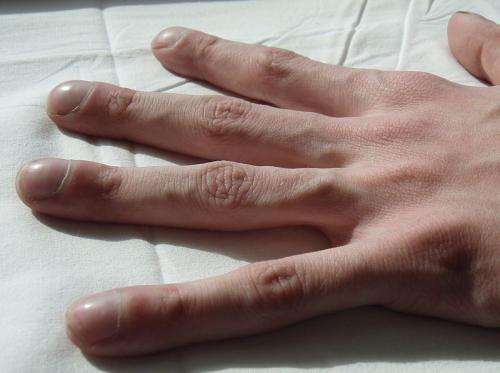Cystic fibrosis and diabetes link explained

Many people with cystic fibrosis develop diabetes. The reasons for this have been largely unknown, but now researchers at Lund University in Sweden and Karolinska institutet have identified a molecular mechanism that contributes to the raised diabetes risk.
"The increased risk of diabetes has previously been explained by the fact that cystic fibrosis causes damage to the pancreas, where the blood-sugar regulating hormone insulin is produced. We are the first research group to show that the mutated gene that causes cystic fibrosis also plays an important role in the release of insulin. The risk of diabetes is not only explained by the destruction of the pancreas", said Anna Edlund, a doctoral student at Lund University Diabetes Centre.
Cystic fibrosis is the result of a genetic mutation in an ion channel that normally regulates salt transport in cells, primarily in the lungs and pancreas. The mutation leads to a wide variety of symptoms. Individuals with cystic fibrosis produce a lot of thick, viscous mucus. This makes their airways sensitive to infection, and repeated or chronic lung infections are common. The secretion of pancreatic juice from the pancreas to the intestine is hindered, which causes diarrhoea and poor weight gain.
Left untreated, cystic fibrosis is fatal, but with improved treatment of symptoms, survival has improved. Many people with cystic fibrosis now live beyond the age of 40.
"Cystic Fibrosis is a severe health condition and diabetes exacerbates an already problematic situation", said Malin Flodström-Tullberg, a researcher at the Centre for Infectious Medicine, Karolinska institutet.
Many people with cystic fibrosis have poor sugar metabolism. At the age of 30, around one in four people with cystic fibrosis also has diabetes that requires treatment with insulin. What the researchers have now shown is that the mutation in the cystic fibrosis gene inhibits the secretion of insulin into the blood, which means that the level is insufficient when the demands on the insulin increase, such as after a meal.
"Normally, insulin is released in two stages. The early stage is a rapid response to raised blood sugar and the later stage aims to restore blood sugar levels. In cystic fibrosis, the early stage of insulin release in particular is insufficient", said Anna Edlund, adding:
"Our results also correspond to clinical observations. Many patients with cystic fibrosis who do not have diabetes have normal blood sugar in a fasting state, but raised blood sugar after a meal."
The researchers have worked on insulin producing cells from mice and deceased donors. They have shown that the cystic fibrosis gene plays an important role in the complex chain of events that precedes the release of insulin.
When the cells were exposed to high glucose levels, they responded as expected by increasing insulin secretion, but when a preparation that specifically obstructs the ion channel expressed by the cystic fibrosis gene was added, the cells' ability to release insulin fell significantly.
"Despite being common among cystic fibrosis patients, surprisingly little is known about the mechanisms behind diabetes in this group of individuals. We need to know what causes the problem in order to develop preventive treatments that improve the cells' ability to secrete insulin. Our study provide a first piece of increased understanding how CFTR contribute to insulin secretion", said Lena Eliasson, Professor at Lund University Diabetes Centre.
More information: Anna Edlund, Jonathan LS Esguerra, Anna Wendt, Malin Flodström-Tullberg and Lena Eliasson. "CFTR and Anoctamin 1 (ANO1) contribute to cAMP amplified exocytosis and insulin secretion in human and murine pancreatic beta-cells." BMC Medicine. DOI: 10.1186/1741-7015-12-87
















